Hostas (plantain lilies) are hardy shade-tolerant flowers you can grow for food or ornamental purposes. Since it is versatile plants, you can find varieties in the broad range of leaf shapes and colors. So, you can pick out among many types of hostas with white, green, blue, gold, and red leaves.
Nowadays, you can find about 45 species of these perennials originated in Asia. The dwarf versions are only 2 to 3 inches (5 – 7.6 cm) high, but the higher ones are about 4 feet (1.2 m) tall. If you provide partial or full shade for them, you will spend very little time on this plant since it requires low maintenance.
Different types of hostas
1. Hosta whirlwind
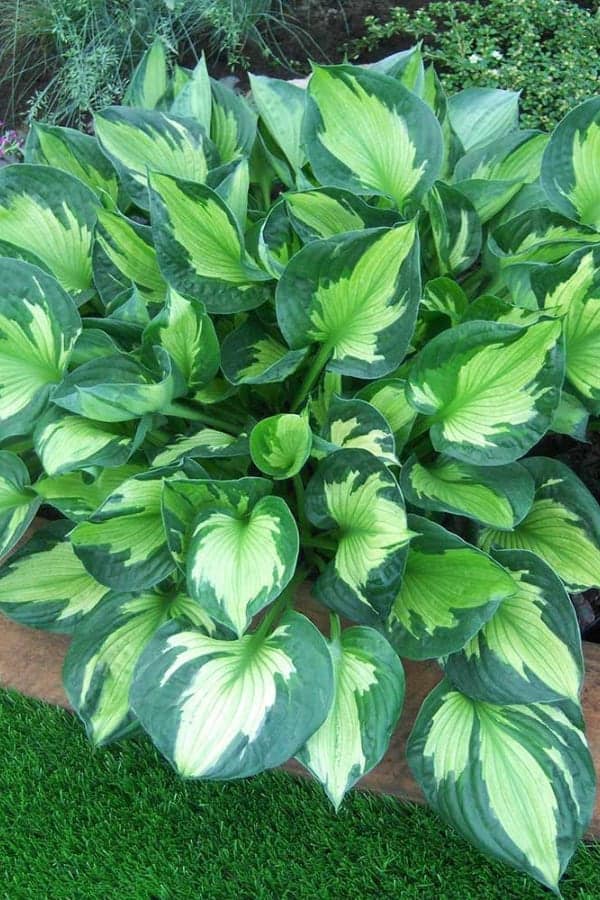
Hosta whirlwind is a perennial with elegant, heart-shaped foliage that changes colors over time. The twisted leaves are creamy-white with dark margins at the beginning, but their centers become dark green at the end of the season.
Beautiful, funnel-shaped, lavender flowers, placed on the 18 to 24 inches (46 – 61 cm) long stems, will bloom in the late summer. The foliage will spread approximately 35 to 40 inches (89 cm – 1 m) wide and stays upright until early winter.
The American Hosta Society awarded this plant as the Best Variegated Hosta in 1992. Many gardeners like this flower because of its colors, versatility, and the possibility to grow in polluted cities. Plant your hostas along borders or in a container, provide fertile soil, and water it regularly. As a result, it will thrive and bloom for an extended period.
2. Hosta komodo dragon
Hosta komodo dragon is one of the giant types of hostas. This attractive perennial prefers growing in the shade. Most gardeners choose this glower as a background plant because of its rich and lush appearance. Plus, it will spread 7 feet (2.1 m) wide.
You can quickly recognize its large, cascading, deeply veined, 15 inches (38 cm) long dark green foliage. Like most other people, you will probably like shallow crust along the leaf edges. Take care to keep your plant safe from slugs and snails, and it will thrive throughout the whole season.
The blooming time is in summer when funnel-shaped, 36 inches (91.5 cm) long, pale-lavender flowers start appearing. Provide enough space for your hostas, and it will beautify your garden for long. Keep in mind that this plant stays dormant during winter.
3. Hosta guacamole
Hosta guacamole is well-known for the exceptional glossy, oval leaves with the yellow-green center surrounded by deep green margins. This plant got a name after its color that resembles a sliced avocado. The most recognizable feature is deep ribs, which extend along the leaf surface.
The foliage supports beautiful, big, white, or pale lavender blooms that appear on the top of 3 feet (91.5 cm) high stems in late summer. Flowers are well-known for their attractive fragrance. The plant is about 2 feet (61 cm) tall and 3 to 4 feet (91. 5 cm – 1.2 m) wide.
This variation of hosta was introduced in 1994 for the first time. Very soon, in 2002, the American Hosta Growers announced it a Hosta of the Year. It is an ideal choice for shade gardens, plus you can grow it in a container when needed.
4. Hosta gracillima
Hosta gracillima (small rock plantain lily, small rock hosta) is a dwarf variety with glossy, heart-shaped, deep green, 4 inches (10 cm) long foliage that spreads about 12 inches (30.5 cm) wide. This particular hosta originated in Japan and has attracted people with unusual narrow leaves with wavy margins.
You can enjoy its funnel-shaped, 2 to 4 inches (5 – 10 cm) high, lavender flowers with purple stripes. They will appear on the top of the 10 inches (25.5 cm) long purple-dotted scape from the late summer to autumn.
This deciduous perennial is an excellent choice for shade gardens, but you can also grow it in a rock garden, along the borders, and in a container. To help your hosta thrive, keep it safe from slugs and snails and cut off the stems after blooming.
5. Hosta halcyon
Hosta halcyon is an attractive mid-sized herbaceous perennial with thick, coarse, frosty blue-green leaves that won’t pale over time. Thanks to its broad, spear-shaped textured foliage, this beautiful plant provides excellent coverage that suppresses weeds. It is approximately 15 to 18 inches (38 – 46 cm) high and spread 30 to 40 inches (76 cm – 1 m) wide.
You can enjoy lance-shaped, pale blue-purple blooms in midsummer if you plant this slow-growing flower in full shade and provide the well-draining soil. It will appear on the top of the 25 inches (63.5 cm) high stem.
Once established, your plant won’t require too much care. Like many other hostas, this is an awarded cultivar. In 1987, the American Hosta Society prized it with the Distinguished Merit Award. Keep in mind that this variation attracts hummingbirds but can be toxic to cats, dogs, and horses.
6. Hosta June
Hosta June is a lovely perennial plant well-known for dense, heart-shaped, blue-green foliage. Each of them has an attractive, irregularly-shaped, yellowish-green center. This easy grower usually reaches 15 inches (38 cm) in height and spreads about 28 to 36 inches (71 – 91.5 cm) wide.
You can expect to enjoy the bell-shaped, 18 to 20 inches (45.7 – 51 cm) high lavender flowers in August. This plant thrives in moist but well-drained soil. Try to save it from slugs and snails, since they damage its beautiful leaves as soon as they appear.
This type of hosta requires full or partial shade, so it is an ideal option for the part of your garden with obstacles blocking the sunlight most of the day. Keep in mind that direct sun can burn leaves and devastate the beauty of this plant.
7. Hosta alligator alley
Hosta alligator alley is a sport of famous American hosta breeder Dick Ward. Its heart-shaped yellow leaves have wide, corrugated, grey-green margins with a yellow center. This hosta is an excellent option for patios and borders, but you can also grow it in a bed and container.
This tall, slow-growing variety can reach about 20 to 22 inches (51 – 56 cm) in height and spread 36 inches (91.5 cm) wide. You can use it as an attractive groundcover to beautify inconspicuous parts of your garden. Since the foliage is medium slug-resistant, you should take care to protect your plant.
This hosta blooms in early summer. Lovely, almost white flowers grow on a long scape, reaching 28 inches (71 cm) in height. Grow it in the shade and provide moist but well-drained soil for the best thriving. Be prepared that your plant needs approximately 2 to 5 years to reach its full size.
8. Hosta august moon
Hosta august moon is a large and vigorous herbaceous perennial, which is about 20 to 24 inches (51 – 61 cm) high and spread 36 to 42 inches (0.9 – 1 m) wide. Its heart-shaped, puckered, pale green leaves are recognizable after the unusual texture.
After exposure to the sunlight, 9 inches (23 cm) long leaves become bright yellow or golden-yellow, depending on the intensity of the sun. They are an excellent choice for groundcover that attracts hummingbirds, but you can also plant your hosta under shrubs. Keep in mind that this plant is not resistant to slugs and snails.
From July through early August, you will see bell-shaped, gray-white blooms flourishing among leaves that form an asymmetrical mound. Flowers are arranged on the 28 to 32 inches (71 – 81 cm) high scape.
9. Hosta blue angel
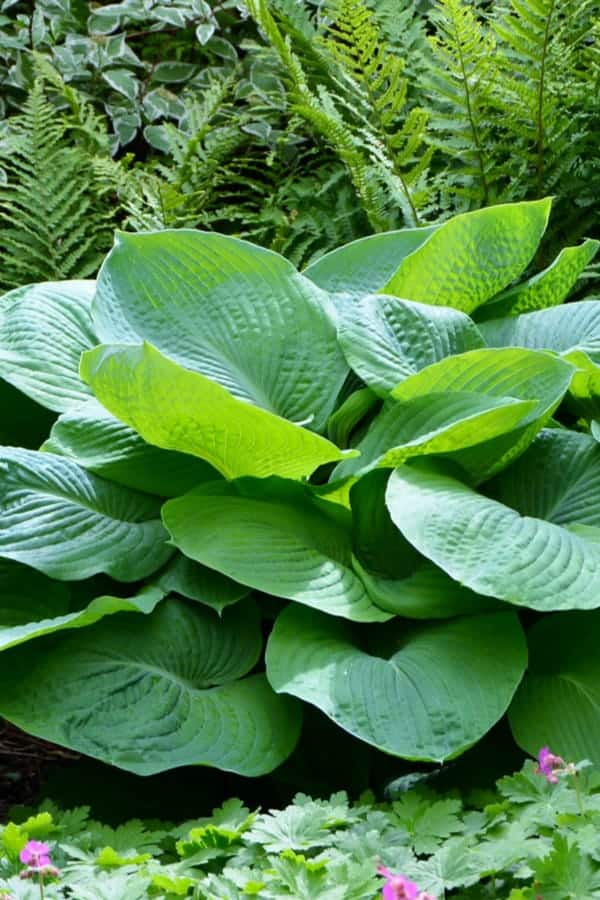
Blue angel is one of the giant types of blue hostas. This outstanding blue-leaved perennial form an attractive mound of thick, wavy, heart-shaped leaves. They are heavily textured, 16 inches (41 cm) long, and dark blue-green with protruding ribbed veins. Their petioles stand upright while the horizontally placed foliage forms the impressive cascade.
This herbaceous perennial grows 36 inches (91.5 cm) in height and spreads about 71 inches (1.8 m) wide. Once established, it will tolerate quite dry soil, but keep your plant safe from slugs and snails.
Showy, funnel-shaped, white to pale lavender flowers, placed on the 48 inches (1.2 m) high scape, will appear from July to August. Grow your plant in part to full shade and protect it from the wind. That way, you will enjoy these long-lasting blooms throughout the summer.
10. Hosta autumn frost
Hosta autumn frost is an unusual, showy variety with an eye-catching mound of blue-green foliage with generous bright yellow margins. That yellow color part will change while maturing and turn creamy-white over time. The mound is approximately 12 inches (30.5 cm) high and 24 inches (61 cm) wide.
You can plant this herbaceous perennial as a useful groundcover, but it is also an excellent option for growing in a container. Whatever you choose, you will enjoy bell-shaped, pale lavender blooms placed on the short, 16 inches (41 cm) high scape that appear from July to August.
The huge advantages of this hardy plant are attracting hummingbirds and low maintenance requirements. Grow it in a shadow place with moist and well-drained soil, cut off stems after flourishing, and keep it safe from slugs and snails.
11. Hosta hyacinthine
Hosta hyacinthine is an attractive herbaceous perennial with slightly puckered, heart-shaped, blue-green foliage that turns gray-green while maturing. Beautiful funnel-shaped, pale lavender flowers appear on the 30 to 34 inches (76 – 86 cm) high, slightly bending scape in late summer. They are placed among the bunch of 8 inches (20 cm) long leaves.
Since this variety is tolerant of sunlight, you can plant it at the place under the direct afternoon sun. This blooming, 12 to 18 inches (30.5 – 46 cm) high and 18 to 24 inches (46 – 61 cm) wide, mounding perennial will attract hummingbirds in your garden.
Plant this medium-sized clump-forming hosta to highly organic, moist, and well-drained soil, and it will beautify your rock garden, borders, and edgings. Take care to protect your plant from the wind, as well as deer, slugs, and snails that feed on the attractive foliage.
12. Hosta crispula
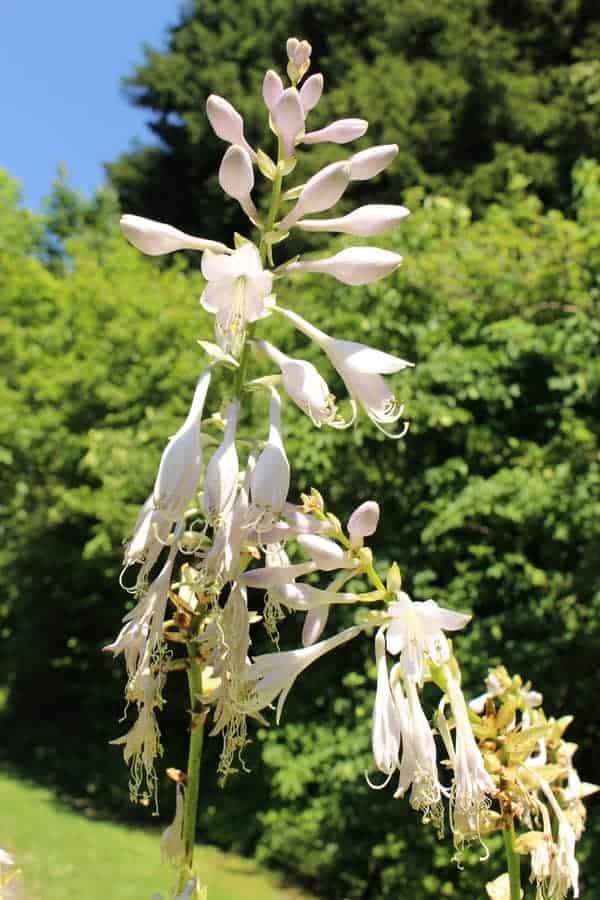
Hosta crispula (curled plantain lily) is an ornamental plant with showy, dark green foliage with creamy-white margins. The best choice is to grow this clump-forming, 24 to 36 inches (61 – 91 cm) high perennial in the shady, moist area as an attractive groundcover.
It will spread about 18 to 24 inches (46 – 61 cm) wide and become an attractive cover for borders and edges. You can also plant it in a container if you prefer that way. In early summer, this lovely plant will prize you with bell-shaped, pale lavender blooms rising above the foliage on the 30 inches (76 cm) high stem.
This type of hosta reaches its full size approximately 2 to 5 years after planting. Take care to cut off the stems regularly and protect your plant from dry winds, coldness, specific pests, as well as slugs and snails that damage its lush leaves. These flowers will attract bees to your garden.
13. Hosta American Halo
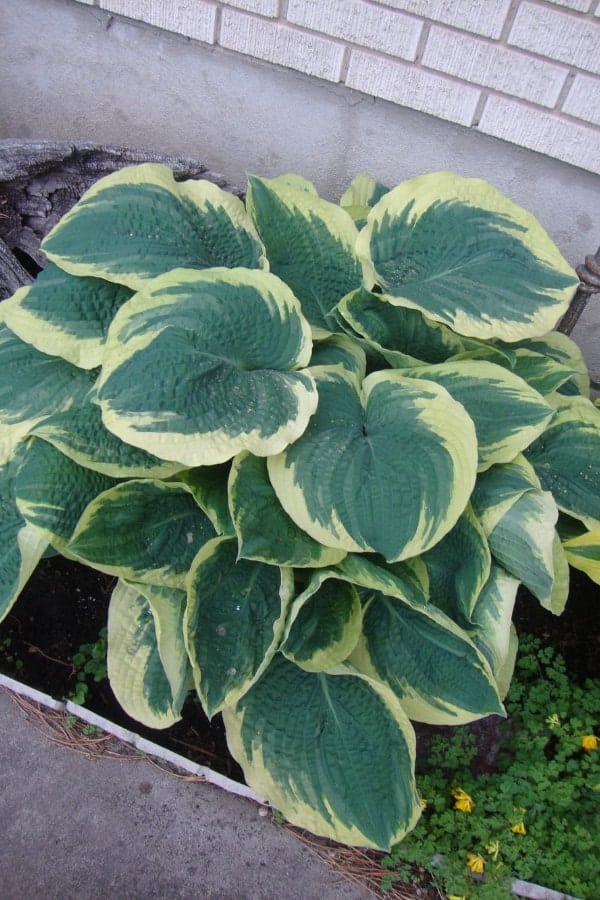
Hosta American Halo is an attractive, hardy plant with elegant, corrugated, blue-green foliage with creamy-white margins that turn white at the end of the season. A dense mound of leaves is about 22 inches (56 cm) high and 60 to 70 inches (1.5 – 1.8 m) wide. That makes this perennial an ideal choice for growing in a bed or as a groundcover.
Since this type of hosta requires low maintenance, it will be enough to plant it in the area with part or full shade. Provide moist, well-drained, and fertile soil for your lovely flower, and it will flourish throughout the summer. Its funnel-shaped, white blooms rise on the 24 inches (60 cm) high scape.
Since this plant is a slow-growing variation, it will reach the full size after about five years. Cut off the stems regularly and keep your plant safe from slugs and snails that feed on the attractive foliage.
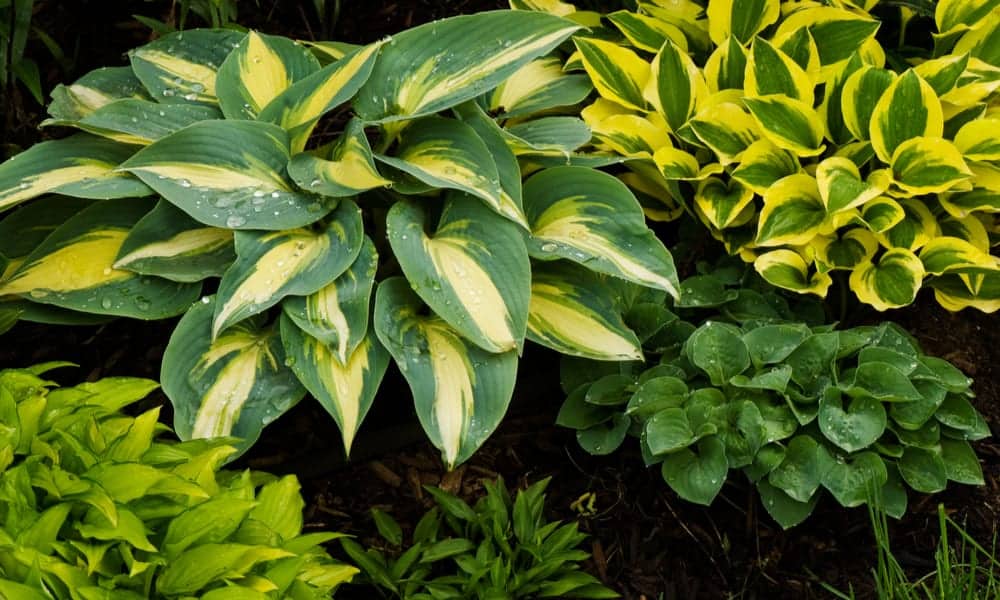
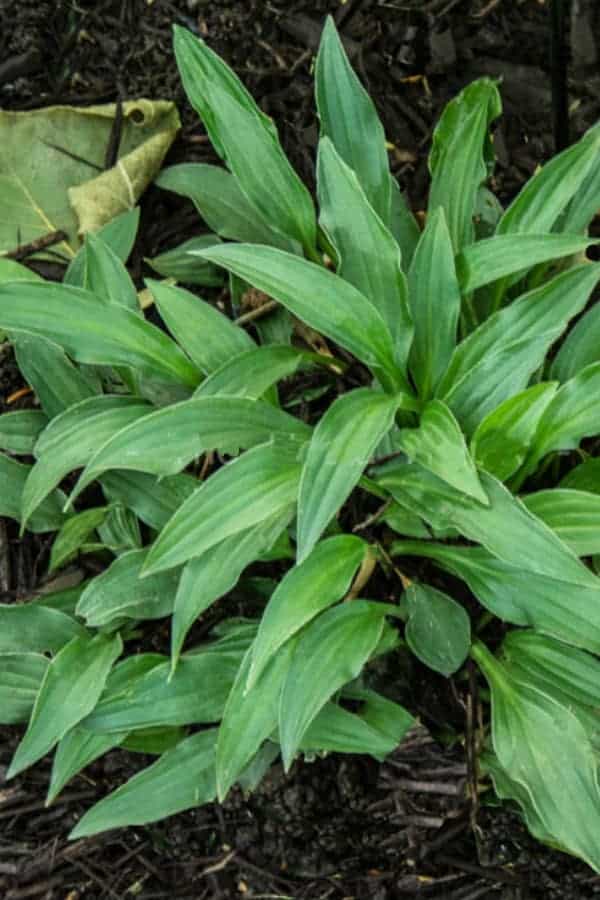
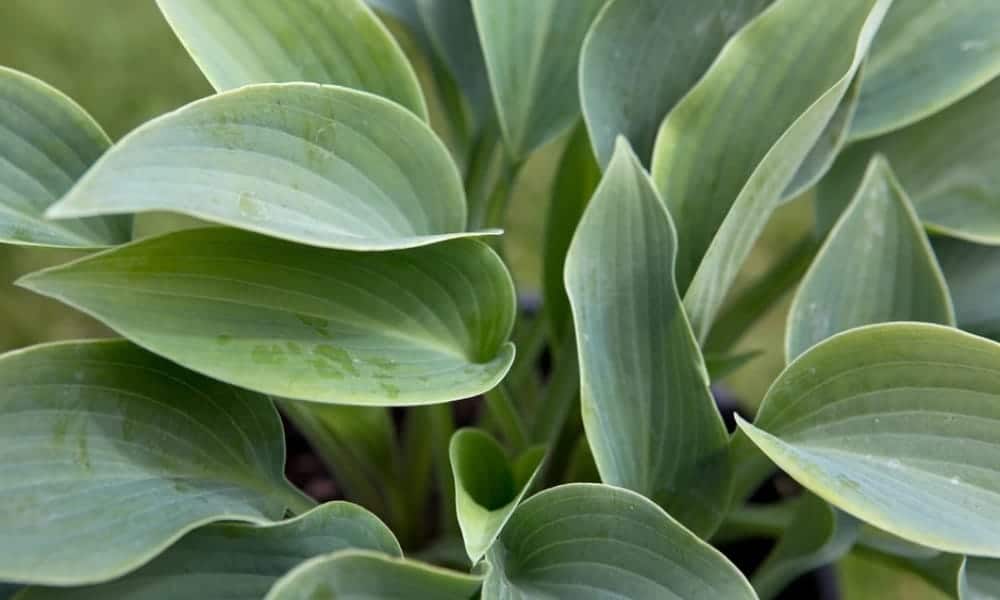
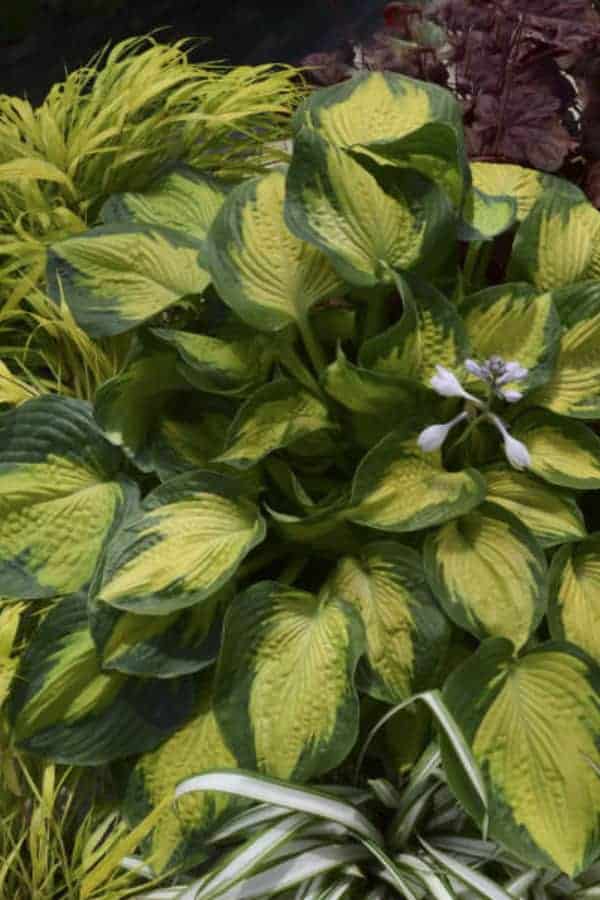
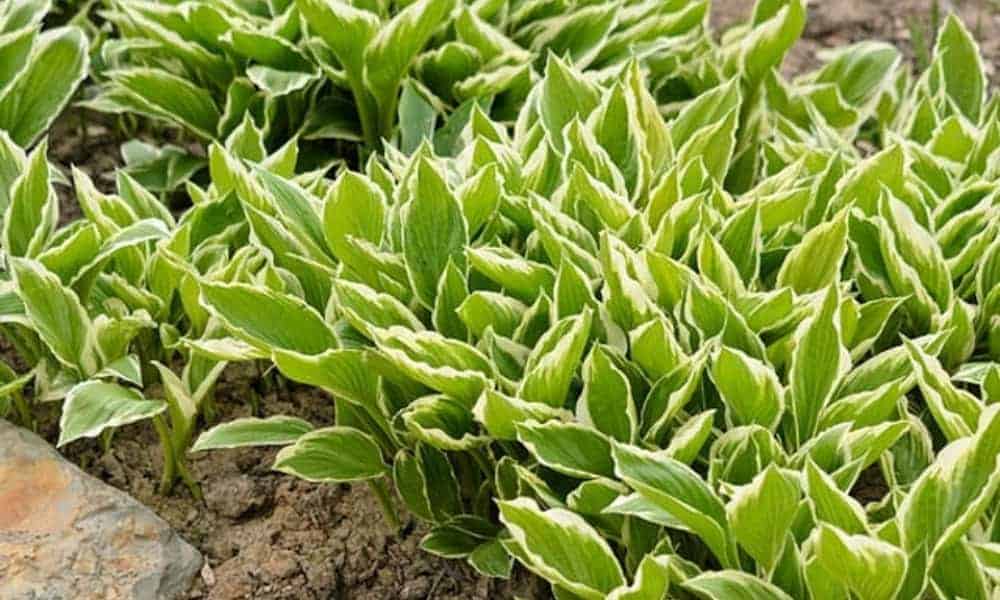
Beautiful, I love them especially Hostas June. How can I get a plant?